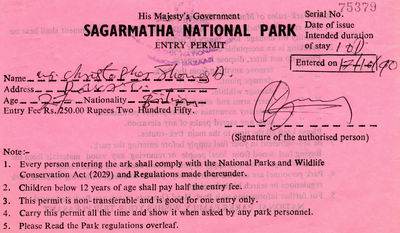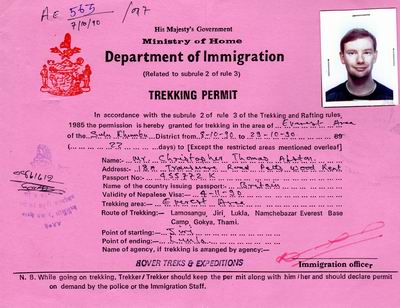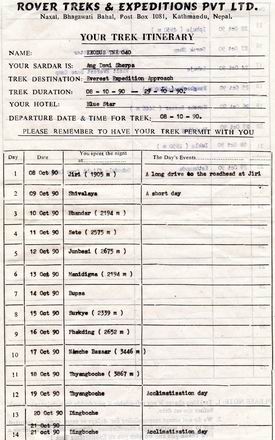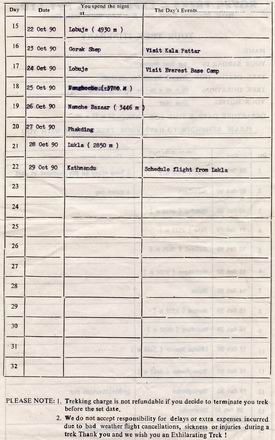After many years of trekking and camping around the Peak District, Snowdonia, Lake District, Dartmoor and the Grampian mountains
and reaching the top of Scafell Pike (3,209ft/978m), Snowdon (3,560ft/1085m) and Ben Nevis (4,409ft/1344m) I discovered a trekking company called
Exodus and decided that a trek to Everest Base camp was an opportunity not to be passed up.
I managed a few photos, in fact, over 500 and this was before digital cameras were 'invented'. I have scanned a few and included them
here along with a shortened form of the diary I kept on the expedition.
The trek followed the classic expedition approach to the Everest massif, used by many famous names as a limbering-up
exercise before the real climbing started from the Everest base camp.
To reach Solu Khumbu, we took advantage of a new road to Jiri – this shortened the time previously required for this
route by two or three days. From here we then walked across the ‘grain’ of the foothills, sometimes in cultivated valleys –
sometimes crossing passes with gradually unfolding panoramas of the distant peaks, descending to the Dudh Kosi river from
where we made our way into the Everest heartland.
Itinerary
Day 1
I met with the other trekkers at Gatwick and we soon realised that this was to be a small group of just 9 people. We departed
by scheduled services of Royal Nepal Airlines. The flight was long especially as RNA had obviously not heard of in-flight entertainment!
Day 2
We arrived in Kathmandu and transferred to our hotel. The rest of the day was free so we explored the capital by ourselves.
Day 3
We were given a sightseeing tour of Kathmandu and surroundings. This was followed by a trek briefing in the evening.
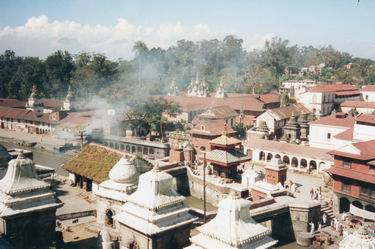
Funeral pyre on the banks of the Bagmati river in centre of Kathmandu
Day 4
An early start and we waited outside our hotel for the tour bus. We all had quite a shock when it arrived and saw what appeared to be many locals
hanging out the windows. We were then informed that these people would be our porters and sherpas for the trek, all 45 of them!
The coach trip took us from Kathmandu to Jiri, first following the road to the Tibetan border and then the new road towards Jiri.
This was our first night camping and we would be camping every night until we returned to Kathmandu on day 25.
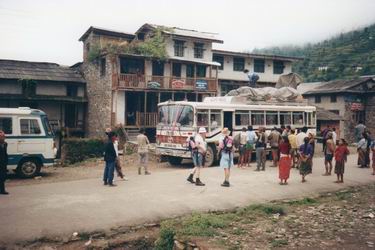
Arrival in Jiri (6,250ft/1905m)
Days 5-9
The first five days of walking took us over four major ridges, giving a good impression of how much we were walking against
the grain of the hills. The first ridge was crossed through forest and pastures at 7,800 ft. We then crossed the valley of the Khimiti Khola
and ascended a steep trail to the Deorali Pass (8,900 ft), which marked a transition into the Tibetan Buddhist regions. The third pass was the
Lamjura (11,580 ft), another fairly stiff climb which took us through dense forest, with magnificent rhododendrons.
An easier climb followed as the trail climbed out of the Junbesi valley to the Salung ridge, from where we had our first
glimpse of Everest. The last pass was the Taksindhu and we then descended to the Dudh Kosi valley.
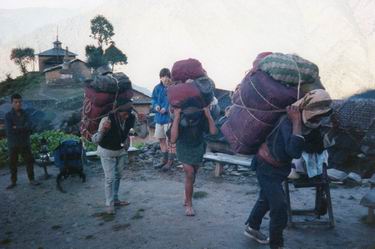 |
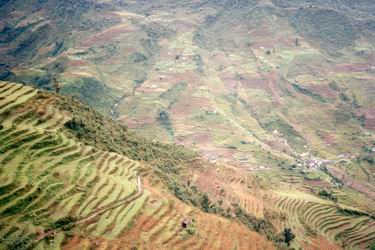 |
| Our porters carrying a standard single load of 30kg |
Terraced land in foothills |
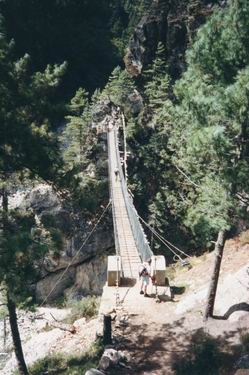 |
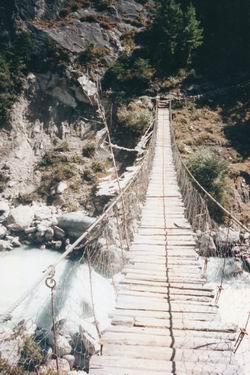 |
| One of the sturdier bridges... |
...and, well let's just say I remember this bridge tilting alarmingly to one side when crossing! |
Days 10-13
We followed the next stage of our trek from the Dudh Kosi valley to Namche Bazaar, the Sherpa ‘capital’ and principal town of the Khumbu region.
The valley was narrow and steep-sided, so we had a fair amount of up and down as the trail rose to 11.300 ft, but there were excellent
views of the peaks. The last stage of the route crossed and recrossed the Dudh Kosi as we walked through magnificent forests of rhododendron,
giant fir and magnolia trees, the ground being covered in bright flowers. After Jorsale (9,200 ft) the trail went
alongside a dripping moss-grown cliff and crossed the west fork of the river, the Bhote Kosi, before we started the steep 2,000 ft climb to
Namche Bazaar. About 1,000 ft up this ascent we had another view of the summit of Everest as it appeared behind the great ridge of
Nuptse-Lhotse. It was in Namche Bazaar that I had my one and only meal of Yak steak!
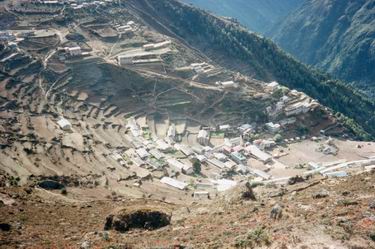 |
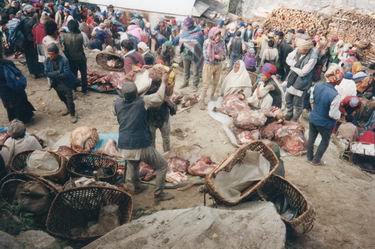 |
| Namche Bazaar (11,286ft/3440m) |
The meat market in Namche Bazaar!! |
Days 14-15
Another day’s walk took us to the remains of Thyangboche monastery (12,700 ft), which had recently burnt down but was now being reconstructed.
Here we had a rest day to acclimatise to the higher altitude.
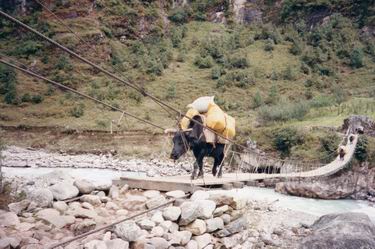
After Namche Bazaar most of the porters headed home and were replaced by Dzos (hybrid of yak and cow)
Days 16-17
We walked to the highest permanent settlement, at Dingboche and here we had another rest day for acclimatisation.
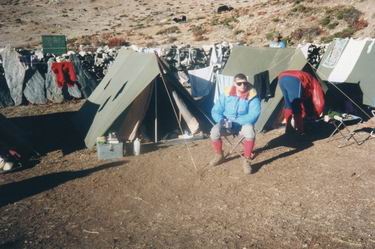 |
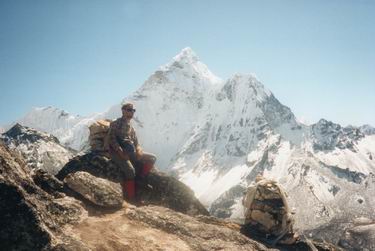 |
| Camp site at Dingboche (14,800ft/4530m) |
Ama Dablam (22,493ft/6856m) from foothills of Pokalde |
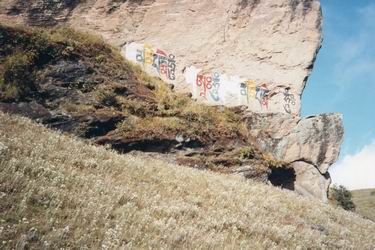 |
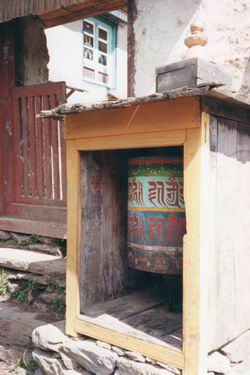 |
| Sanskrit mantra "Om mani padme hum" |
Prayer wheel with mantra |
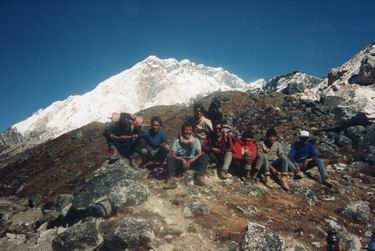
Our sherpas that guided us to Everest Base Camp. Head sherpa Anf Domi is 3rd from left.
Days 18-20
From Dingboche the trail climbed a wide valley sloping gently up to Dugla and then we climbed more steeply onto the terminal moraine of the
Khumbu glacier, an amazing sight. Further along, we came to Lobuche at another tiny yersa (stone hut used by herdsmen in the summer)
with a few teahouses for the trekking season. This was our base for the next two nights.
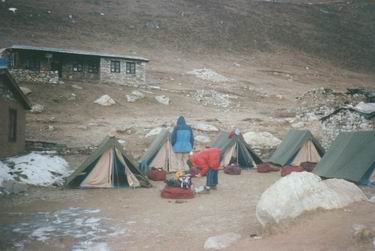 |
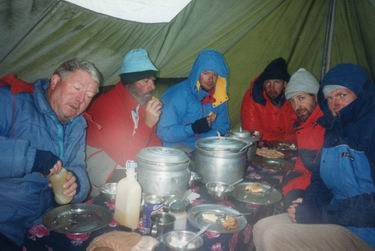 |
| Camp site at Lobuche (16,210ft/4940m) |
Breakfast at 5.30am before leaving for Kala Pattar, consisting of rice pudding, omelette and a hot drink |
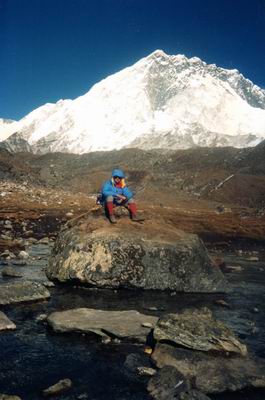
Mehra Peak 5820m
Now we are surrounded by giant Himalayan peaks. Everest, Nuptse, Lhotse, Pumori and Ama Dablam tower above us and the sight of their snows
glowing gold and pink at sunset and sunrise is quite unforgettable. We followed the Khumbu glacier northwards to Gorak Shep at 17,000 ft for
a view of the South Col of Everest. We climbed the small peak of Kala Pattar (“black rock”) at 18,492 ft/5545m and looked down over
the base camps of the various Everest expeditions. Although exhausting, this climb afforded a most magnificent view of the Khumbu Glacier,
the base camp area and above all a close-up sight of the world’s highest mountain. The British in the 19th century named this mountain after
Sir George Everest, Head of the Survey of India, but to the Nepalese it is Sagarmatha – ‘Head of the Waters’ and to the Tibetans and Sherpas,
Chomolungma - ‘Mother of the World’. That night we camp at Gorak Shep (16,942ft/5164m) and this remains the coldest night (minus 18c) that I have ever
spent under canvas!. Gorak Shep is the original base camp.
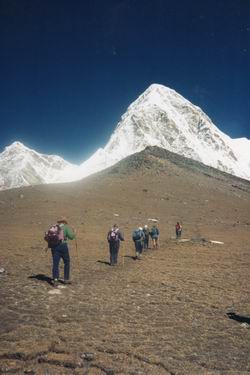 |
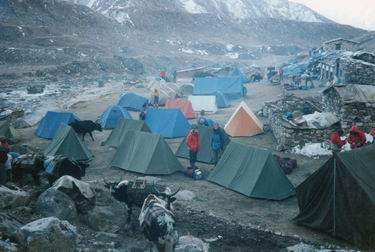 |
| The trek to Kala Pattar with Pumori in the background |
Camp site of Gorak Shep |
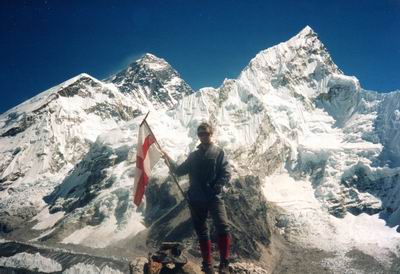 |
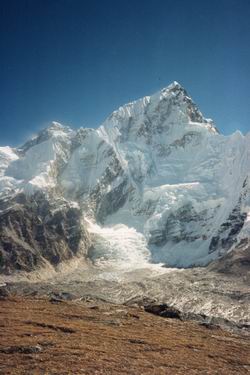 |
| Lho La 6006m, Everest 8848m & Nuptse 7879m as viewed from Kala Pattar |
Khumbu Icefall |
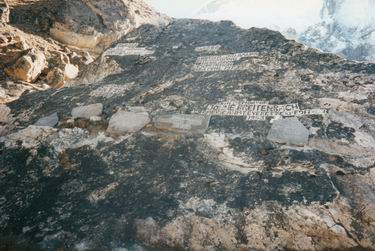 |
 |
| Memorial at Gorak Shep |
Camp site of Gorak Shep |
The following day we visited Everest Base Camp at 17,598ft/5364m, for a close view of the Khumbu icefall.
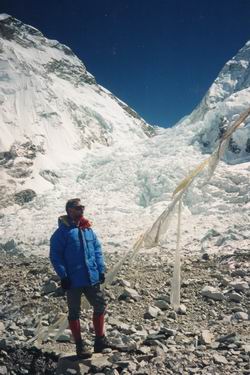 |
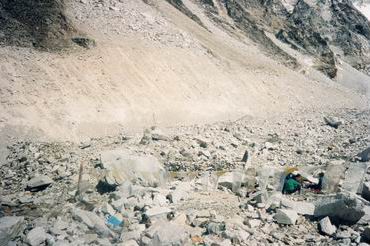 |
| Prayer flags at the foot of Khumbu icefall |
Everest Base Camp, a very bleak place |
Days 21-24
We retraced our route and travelled much faster as we had acclimatised and were going downhill. Down through Pheriche and Pangboche where we entered
the treeline once more, the trail returned to the monastery at Thyangboche. After crossing the Dudh Kosi at Phunki Tangkha, we returned to
the main route and descended through Namche Bazaar. We finally picked up our outward trail again, followed the Dudh Kosi south through
rhododendron and pine forests, past Jorsale, Mondzo and Benkar to Chaurikharka. Here we left the main trail and climbed to the small airstrip
of Lukla. Our last night of camping.
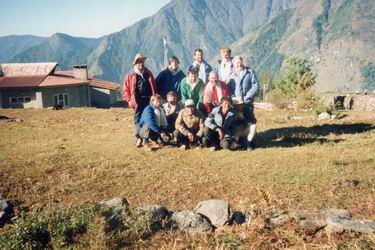 |
 |
| Final group photo at Lukla (9,383ft/2860m) |
Lukla Airstrip. A bit unnerving when you see planes take-off and disappear before re-appearing as they climb out of the valley! |
Day 25
We flew back to Kathmandu via helicopter.
Days 26-27
We had another 2 days to explore.
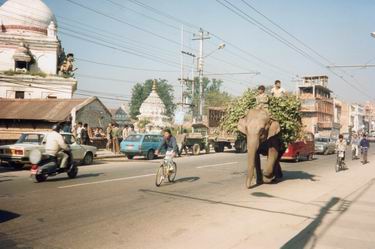 |
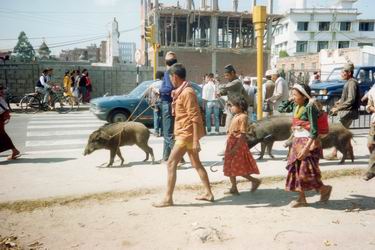 |
| Everyday sights... |
...on the streets of Kathmandu |
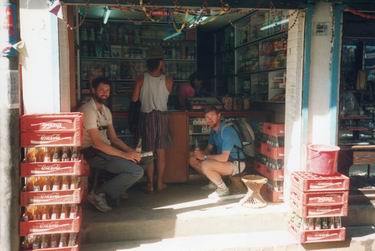
One last drink...
Day 28
In the evening we left Kathmandu by air for London.
Day 29
We arrived back in London after what really seemed like a real lifetime adventure.
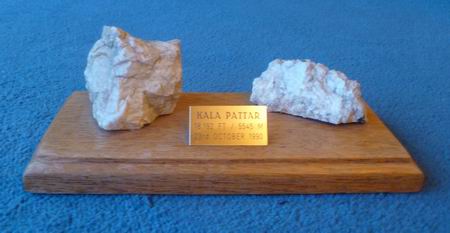
Activities


